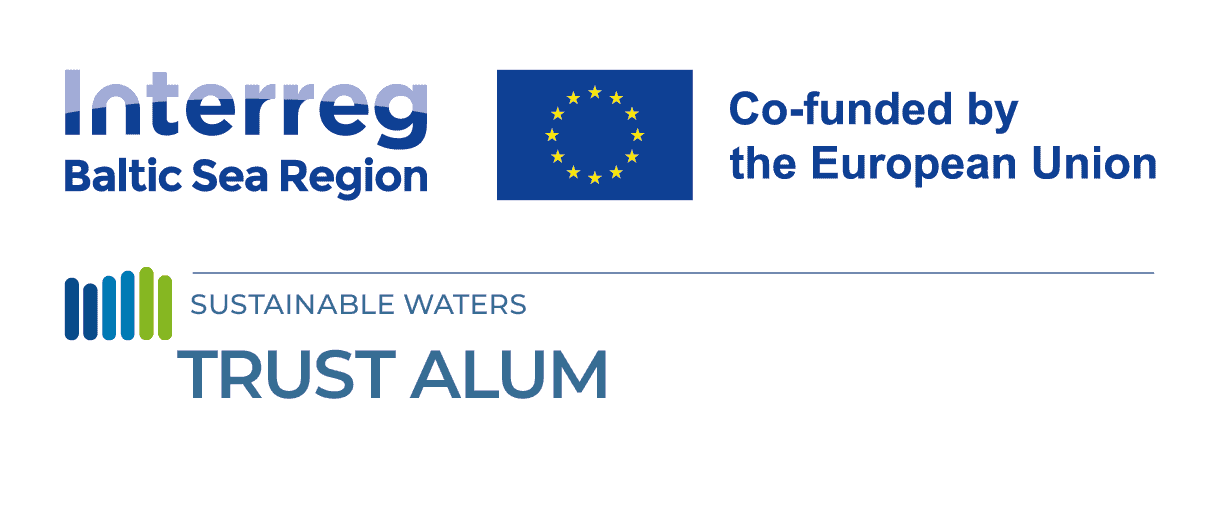
Frequently Asked Questions
24 March 2024
 Why do we talk about lakes’ water quality if they suffer from eutrophication only in August?
Why do we talk about lakes’ water quality if they suffer from eutrophication only in August?
The categorization by amount of organic matter (i.e. eutrophic, mesotrophic and oligotrophic lakes) is constant throughout the year, meaning lakes do not become eutrophic in August only. Eutrophication is evidenced by the content of nutrients (nitrogen, phosphorus) and the growth of associated aquatic plants (algal and aquatic plant growth and subsequent organic matter accumulation). Thus, water quality is important throughout the year and is viewed as a whole and not only in a single month of the year.
 If the project fails, shall we lose the lake as a recreation place?
If the project fails, shall we lose the lake as a recreation place?
The biggest risk for failure of the project would be insufficient phosphorus binding, which does not mean the recreation place is lost, meaning eutrophication will not be prevented as much as possible. There is also a risk that the external input of nutrients like phosphorus is still too high, and this would cause a future build-up of excess phosphorus in the sediment once again. This is why we model the water quality in the lake. This allows us to determine where nutrients like phosphorus enter the lake, either from the outside or from the sediment where legacy phosphorus has accumulated in the past.
 Why are nature-friendly and risk-free mechanical cleaning methods not chosen to clean the lake?
Why are nature-friendly and risk-free mechanical cleaning methods not chosen to clean the lake?
Mechanical treatment methods (such as removing sediment) are much more expensive and could have a significant impact on the area around the lake, especially if there are lots of big trees around the lake, a beach, a children’s playground etc. In addition, a lot of benthic invertebrates (e.g. crustaceans that live in the sediment), are removed from the lake. Benthic invertebrates are an important part of the lake, for example as food for fish.
 The sediment environment of the lake is very dynamic. Is it really possible to quantify everything and predict all the circumstances?
The sediment environment of the lake is very dynamic. Is it really possible to quantify everything and predict all the circumstances?
We build our trust on experience in Sweden, where this method has helped to restore over 30 lakes in Sweden and several hundred lakes around the world over the last 60 years. So yes, it is possible to calculate and predict the circumstances in such a way as to draw conclusions about whether the method is suitable for a particular lake and how this method should be applied. Prior to treatment, the lake undergoes a highly detailed feasibility study over four seasons (June 2023 to April/May 2024 in our case) where both the water and sediment are collected and analysed. A dynamic lake model will be constructed to determine the effectiveness of the ALUM method and a geo-mathematical model will be created to calculate the amount of Al salt solution required.
 Could treatment be started in the autumn rather than during the swimming season?
Could treatment be started in the autumn rather than during the swimming season?
The treatment requires certain weather conditions (a temperature of at least 10 degrees in water and before phosphorus intake by algae occurs), so spring is the earliest time when it can be started, the period at the end of April to the beginning of May, has been chosen so that treatment is already completed during the active swimming season (summer). Treatment will not restrict swimming. People should not swim while the lake is having a treatment boat moving in the water (due to safety conditions as the boat is large), but otherwise there are no restrictions.
 Why has a “chemical” method been chosen for the care of a socially important lake, which nevertheless involves risk rather than mechanical lake treatment methods? The chemical effect is irreversible.
Why has a “chemical” method been chosen for the care of a socially important lake, which nevertheless involves risk rather than mechanical lake treatment methods? The chemical effect is irreversible.
Mineral compounds will be used when applying the ALUM concept method. Although aluminium salts like Alum are technically chemical (or salt) solutions, once added to the water, a mineral is formed that binds permanently with phosphorus. There are, however, risks with any method, but these can be minimized for the ALUM method. There is also a general risk that these types of methods are less effective than expected, which is also a risk in ALUM concept method. This is why we model the lake as well before treatment.
The human body also consists of chemicals, i.e. more than 90% of the human body is made up of oxygen, carbon, hydrogen, nitrogen, calcium and phosphorus, and by the way, also aluminium in small quantities. Aluminium is also the third most common element in the earth’s crust and the most abundant metal in the earth’s crust. Thus, it is quite common in the environment and is also already present in lake sediments naturally. Elevated doses of aluminium, like elevated doses of many other elements, may cause the body to respond, while it should be noted that in Lake Velnezers found aluminium concentrations are 0.06 mg/L, while allowed drinking water aluminium concentration is 0.2 mg/L.
The mechanical lake treatment method for sediment removal (often called dredging) is financially demanding and therefore not available to all municipalities. In general, sediment removal costs 5-10 times more than an aluminium treatment. However, if the sediments do not have heavy metals or other pollutants in them, the sediment can be reused, potentially lowering the cost of treatment. In most cases though, if nutrients are elevated due to human activity around the lake, pollutants and toxins will also be elevated because the sediment is a sink for both nutrients and pollutants.
Dredging also has risks associated with it. The main ones being that important biota in the lake are removed and killed, including macrophytes (aquatic plants) and benthic invertebrates. Aquatic plants are an important food source for birds and fish, and also stabilise the sediment. Benthic invertebrates are also an important food source for fish. Additionally, there are often stores of heavy metals and other toxic compounds buried deeper in the sediment from past inputs to the lake. These are now stabilised by new sediment over the polluted layers, but the upper layer of sediment is where most of the phosphorus is found. If this upper layer of sediment is removed, there is a risk that these old stores of pollutants become exposed and enter the water and fish in the lake. Finally, there are very few cases of lakes that have met water quality goals after dredging. Phosphorus rich sediment often has a water content of 90-95 %, which means it is difficult to remove adequately because as soon as some is removed, that hole or trench created is filled from the side with phosphorus rich sediment.
 Have there been increased levels of phosphorus in Lake Velnezers (the lake chosen for treatment in Latvia)?
Have there been increased levels of phosphorus in Lake Velnezers (the lake chosen for treatment in Latvia)?
Yes, the lake is classified as a eutrophic lake and has an increased amount of nitrogen and phosphorus that contribute to overgrowth of the lake’s shoreline area, mass reproduction of small algae, including occasionally increased growth of cyanobacteria (blue-green algae) that have the ability to produce and release toxins.
 Are there negative examples of lake treatment using this method? Were negative examples analyzed to avoid them?
Are there negative examples of lake treatment using this method? Were negative examples analyzed to avoid them?
Of course, all possible aspects are analysed before a project of this scale can be carried out, otherwise such activities would be neither safe nor financially justified. Based on the experience of the partners, there are several examples of improperly conducted lake investigations before treatment in Sweden. In these cases, there was no feasibility monitoring done before treatment nor proper modelling to determine the required dose of the aluminium needed. This resulted in a shorter than expected longevity of treatment due mainly to still elevated inputs of nutrients to the lake. These elevated nutrients caused a new, excess build-up of phosphorus in the sediment.
There may also be less than optimal experiences due to reduced phosphorus binding efficiency, i.e. the mineral does not bind as much phosphorus as possible. This can be avoided by precisely modelling the amount of aluminium to be added, which is the reason for regular survey of the lake prior to application of the method to obtain the required model parameters and optimize the treatment.
Finally, a recent treatment of a lake in Finland was slightly acidified in some parts of the lake (pH between 5.5 and 6). The pH recovered quickly, but a small number of fish died. No lake modeling was conducted and no geochemical model was used in order to properly design the treatment and prevent this type of risk. In addition, pH was not consistently monitored during treatment. Any one of these measures would have prevented the undesired outcome, and all three will be conducted as a part of trust ALUM.
 Will aluminum be bound in sediments and will not leak into lake waters?
Will aluminum be bound in sediments and will not leak into lake waters?
Yes, that is the purpose. By the way, the aluminum compound which will be used in the lake, is also used for the treatment of drinking water and wastewater.
 What are the differences in the use of the Al method in soft and hard water lakes?
What are the differences in the use of the Al method in soft and hard water lakes?
Alkalinity is much higher in hard water lakes and therefore these lakes have a higher buffering capacity and it is harder to change water pH. In soft water lakes, alkalinity is lower and we can add much less aluminium.
 Under what circumstances is aluminum safe for the lake, sediment? Under what circumstances does it become harmful?
Under what circumstances is aluminum safe for the lake, sediment? Under what circumstances does it become harmful?
Aluminum sulphate is only one form used in the ALUM concept method, other aluminum salt compounds may also be used. No matter which type of Al salt solution is used, the same aluminum mineral compound forms and becomes part of the sediment. For example, PAC (polyaluminum chloride) can be used and will work similarly to aluminum sulfate in the lake. Aluminum is widespread in the environment naturally but can become harmful at increased concentrations when pH is very low (< 5.5) or very high (>9). Hence this method is not appropriate for bog lakes with low pH, for example. pH and aluminum are therefore continuously measured in the lake water during and after treatment to ensure safe conditions during treatment. If the pH decreases more than acceptable, the treatment is stopped to let pH stabilise. If negative effects are suspected, the treatment will be stopped entirely.
 Softwater lakes prevail in Scandinavia. What is the experience of using Al method in hardwater lakes?
Softwater lakes prevail in Scandinavia. What is the experience of using Al method in hardwater lakes?
Even in Sweden there are hard water lakes close to Stockholm and the Uppsala area but this is true, soft water lakes prevail in Sweden. There are a lot of experiences with hard water lakes in EU countries and North-America. Historically the longevity of treatment is longer in hard water lakes because you can add more aluminium in one time (treatment). With newer treatment methods developed using recent research, however, it is possible to successfully treat both hard and soft water lakes.
 The mixing of sediments is facilitated by both benthivorous fish but also wind. Wind induced sediment mixing is a common phenomenon in shallow lakes. How wind exposed shallow lakes should be treated with aluminium?
The mixing of sediments is facilitated by both benthivorous fish but also wind. Wind induced sediment mixing is a common phenomenon in shallow lakes. How wind exposed shallow lakes should be treated with aluminium?
The method of adding aluminium is very important. Aluminium injection in the sediment matrix is definitely more efficient in this case. And there is less risk the mineral will blow other areas of the lake because it is injected into the upper 10-15 cm of sediment.
 What happens if you have too much Al salt in the water and its not going to bind P? What happens with the natural lake?
What happens if you have too much Al salt in the water and its not going to bind P? What happens with the natural lake?
It’s a question of binding efficiency. The mineral itself does not change, but the Al flocs´ surface area decreases and therefore the binding ability of the P decreases. It means that there is still too much mobile P in the sediment. This can be solved by splitting the treatment into multiple, smaller treatments to improve binding efficiency.
 If the benthivorous fish stock is high in the lake then they will keep the sediment layer busy helping to release P from sediments. Is there any point in Al treatment alone?
If the benthivorous fish stock is high in the lake then they will keep the sediment layer busy helping to release P from sediments. Is there any point in Al treatment alone?
We have seen that actually sediment mixing caused by fish can improve the binding efficiency. You can/need to increase the Al dose but the longevity of treatment may be at risk.
It is better to combine benthivorous fish removal and Al treatment. Fish removal helps restore a better balance among the fish stock (piscivorous versus planktivorous and benthivorous) of the lake and should help the eutrophic lake recover more sustainably in the long-term.





